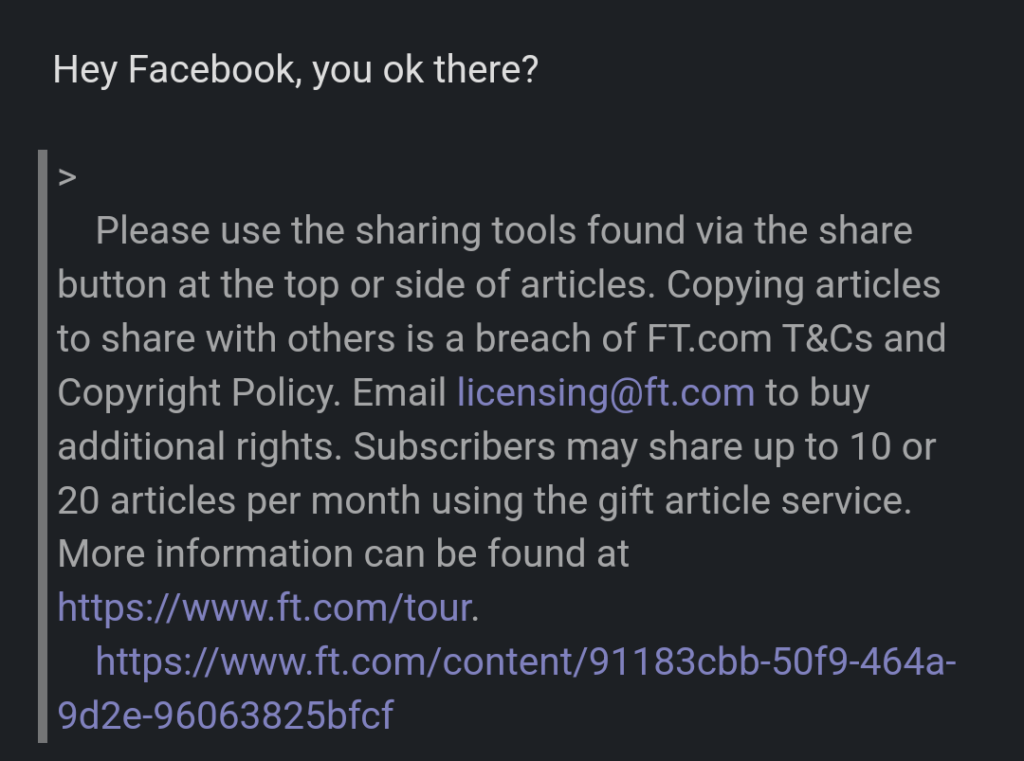The Dead Internet Reality
Facebook and Instagram introduce AI bot ‘user’ accounts
Hey Facebook, you ok there?
Meta plans to roll out generative AI (genAI) characters on Facebook and Instagram this year in an effort to boost user engagement.Also, they apparently also deleted these accounts after the backlash, with some excuse about it being a “test product” and that it was run by humans on the backend. You know it will come back though. These companies have wasted too much time and money on this AI garbage to turn back now.
But one, I don’t know why they need to do this, these platforms are already overrun with AI “influencers”. And those influencers are already posting what they know will drive traffic, AI ladies with boobs and skimpy clothing. Not boring AI soccer moms.
Two, and, less jokingly, if they want to drive user engagement, then maybe they could try promoting… engagement with… users?
I can only speak to how I use Facebook, but I have heard plenty of people say they don’t really use it anymore because it never shows them what they want. Same for Instagram. I have no idea about Threads, for the “Microblogging Wars” I have already given up on Threads. My OpenVibe app crossposts to it, when I remember to use it instead of the native clients, but at this point, I am just, Bluesky and Mastodon. Bluesky for “what’s hip and current and meme-able”, Mastodon as the underlying pulse of the old-school nerdy internet.
But I am not here to discuss other platforms, just Facebook’s various platforms. I’ve established I don’t use Threads. I really don’t use Instagram either. Insteagram is like 90% videos now, which I absolutely LOATHE. I want photos, I use Instagram for PHOTOS. If I wanted videos I would use TikTok or Youtube, but I don’t really want videos ever. I check on TikTok like once a month to catch up on the 3 accounts I actually care about.
Instagram is also way too inundated with ads every other post. And yes, I am including “you might like this” in ads. I want to see posts from people I followed, I followed them for a reason, because I found their posts interesting, or in some cases because they were not “amazing” but I want to feel encouraging. Because I know I am in that latter group. Because I don’t need to ONLY see perfect, edited, amazing 10,000 likes photos, I want to see the 2-likes mediocre ones too.
But instead, it just keeps suggesting things to me, or showing ads.
Facebook has a similar problem. They want users to interact and comment and treat their groups like little forums. But then when I join a group, or like a page, it never actually shows me that content. Just, more suggestions. I don’t need to join 10 Aurora fan groups and a dozen Retro Gaming groups, show me content from the ones I am already in damn it.
And I definitely don’t need these spaces filled with AI garbage. Because these fake “influencers” are only going to be used to promote more ads. When I look for suggestions from people, I want real people who have actually used this crap, not some AI trained on an ad read.
Speaking of broken and dead internet, when pulling a quote, for context, from another website, it copied and pasted an additional hidden section as well…

Like, thats not how this work, that’s not how any of this works. The internet is made for sharing. I don’t think Financial Times would sue me or anything for removing their stupid blub, but instead, I just changed the quote and linked news article. So now you get nothing FT.
Bravo. Now the marketer website can get the zero click-throughs I generated by linking it.
Josh Miller aka “Ramen Junkie”. I write about my various hobbies here. Mostly coding, photography, and music. Sometimes I just write about life in general. I also post sometimes about toy collecting and video games at Lameazoid.com.